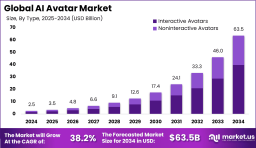

The Global AI Avatar Market is projected to surge from USD 2.5 billion in 2024 to USD 63.5 billion by 2034, expanding at an exceptional CAGR of 38.2%. This growth is driven by increasing adoption of AI avatars in customer service, virtual influencers, gaming, healthcare, and education. These digital entities enhance human interaction, personalize user experiences, and streamline operations across sectors. As businesses embrace automation and immersive engagement, demand for lifelike, intelligent avatars is accelerating. The fusion of AI, NLP, and 3D modeling is transforming how people communicate with technology, unlocking new revenue models and engagement channels.
Key Takeaways:
Market Size in 2024: USD 2.5 Billion
Forecasted Size by 2034: USD 63.5 Billion
CAGR (2025–2034): 38.2%
North America 2024 Share: 39.2% (USD 0.9 Billion)
High demand in customer service, gaming, and virtual influencers
Surge in avatar deployment in metaverse platforms
Increased AI-human interaction via voice and facial recognition
Driven by personalization and cost-efficient engagement
Dominant Market Position:
North America leads the AI Avatar market with a 39.2% share in 2024, valued at USD 0.9 billion, owing to robust AI infrastructure, strong presence of tech innovators, and high adoption in entertainment, customer service, and virtual platforms. The region benefits from an innovation-friendly environment and early adoption of metaverse and AR/VR applications. Europe follows closely due to advancements in digital identity, multilingual AI development, and regulatory focus on AI ethics. Meanwhile, Asia-Pacific is witnessing rapid growth, driven by mobile-first economies, strong gaming culture, and rising use of avatars in social media, e-commerce, and education applications.
Technology Perspective:
AI avatars rely on a combination of machine learning, natural language processing (NLP), computer vision, 3D rendering, and voice synthesis. NLP enables avatars to understand and respond to users naturally, while computer vision facilitates realistic facial movements and lip-syncing. Deep learning algorithms allow adaptive learning and emotional intelligence simulation. Advanced 3D modeling and animation software help create hyper-realistic digital humans. Cloud-based platforms and generative AI tools enable real-time rendering and scalability. Integration with AR/VR, metaverse platforms, and wearables enhances interactivity, allowing AI avatars to exist across diverse virtual ecosystems, improving personalization, accessibility, and user immersion.
Dynamic Landscape:
The market is evolving rapidly through technological breakthroughs, creative experimentation, and metaverse integration. Companies are partnering with entertainment, retail, and education sectors to deploy interactive, multilingual, and cross-platform avatars, reshaping digital engagement experiences.
Driver, Restraint, Opportunity, Challenge:
Driver: Rising demand for hyper-personalized digital experiences.
Restraint: Ethical and privacy concerns around digital identity replication.
Opportunity: Expansion in virtual commerce, education, and healthcare.
Challenge: Maintaining realism, emotional intelligence, and real-time performance.
Use Cases:
Virtual influencers for brand promotion and marketing
AI-powered customer support avatars
Educational avatars for tutoring and training
Healthcare assistants for mental wellness and diagnostics
Virtual characters in gaming and streaming platforms
Human-like digital hosts for events and product demos
Personal finance and productivity coaching avatars
Metaverse-native avatars for digital identity representation
Key Players Analysis:
Key players are leveraging AI, CGI, and emotion-sensing capabilities to create high-fidelity avatars across industries. These companies invest in multi-language NLP, facial animation engines, and cloud-based deployment to ensure broad accessibility and performance. Strategic collaborations with media firms, e-learning platforms, and social networks are expanding reach. Firms are also adopting subscription-based and SaaS models to scale avatar customization. Their competitive edge lies in integrating avatars with AR/VR and mobile platforms, enabling 24/7 user interaction. Emphasis is placed on inclusivity, realism, and ethical AI. Continuous updates to voice tone, gestures, and behavior increase realism and engagement, positioning them for future dominance.
Recent Developments:
Launch of multilingual AI avatars for global customer support
Integration of avatars into enterprise metaverse platforms
Introduction of emotion-detecting avatars for mental health apps
Real-time voice cloning and avatar lip-sync improvements
Partnership between avatar creators and e-commerce firms
Development of AI avatars for live virtual events and streams
Conclusion:
The AI Avatar Market is revolutionizing human-computer interaction, enabling businesses to deliver lifelike, scalable, and personalized experiences. With advancements in AI, 3D tech, and immersive environments, digital avatars are poised to redefine engagement across sectors. As ethical frameworks evolve and technologies mature, the market is set for sustained innovation and global adoption.
| No comments yet. Be the first. |